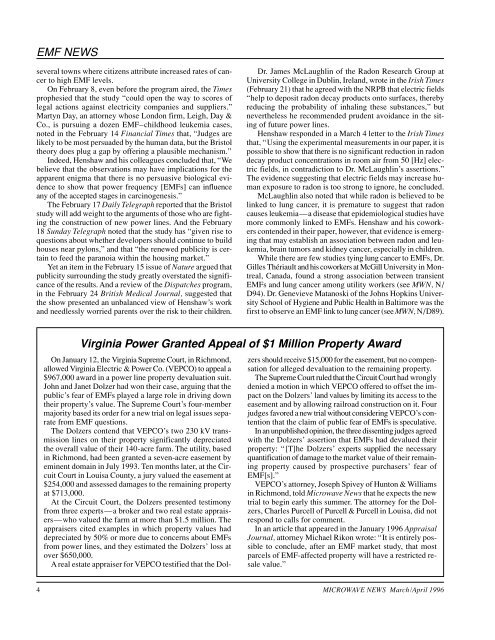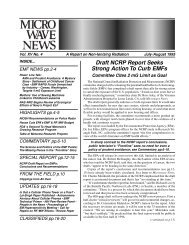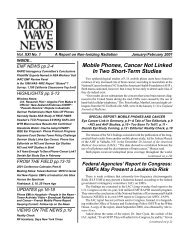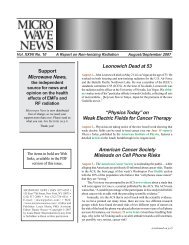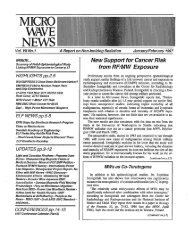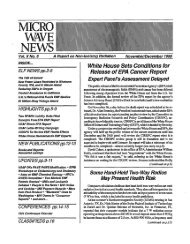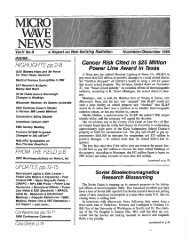You also want an ePaper? Increase the reach of your titles
YUMPU automatically turns print PDFs into web optimized ePapers that Google loves.
EMF NEWS<br />
several towns where citizens attribute increased rates of cancer<br />
to high EMF levels.<br />
On February 8, even before the program aired, the Times<br />
prophesied that the study “could open the way to scores of<br />
legal actions against electricity companies and suppliers.”<br />
Martyn Day, an attorney whose London firm, Leigh, Day &<br />
Co., is pursuing a dozen EMF–childhood leukemia cases,<br />
noted in the February 14 Financial Times that, “Judges are<br />
likely to be most persuaded by the human data, but the Bristol<br />
theory does plug a gap by offering a plausible mechanism.”<br />
Indeed, Henshaw and his colleagues concluded that, “We<br />
believe that the observations may have implications for the<br />
apparent enigma that there is no persuasive biological evidence<br />
to show that power frequency [EMFs] can influence<br />
any of the accepted stages in carcinogenesis.”<br />
The February 17 Daily Telegraph reported that the Bristol<br />
study will add weight to the arguments of those who are fighting<br />
the construction of new power lines. And the February<br />
18 Sunday Telegraph noted that the study has “given rise to<br />
questions about whether developers should continue to build<br />
houses near pylons,” and that “the renewed publicity is certain<br />
to feed the paranoia within the housing market.”<br />
Yet an item in the February 15 issue of Nature argued that<br />
publicity surrounding the study greatly overstated the significance<br />
of the results. And a review of the Dispatches program,<br />
in the February 24 British Medical Journal, suggested that<br />
the show presented an unbalanced view of Henshaw’s work<br />
and needlessly worried parents over the risk to their children.<br />
4<br />
Dr. James McLaughlin of the Radon Research Group at<br />
University College in Dublin, Ireland, wrote in the Irish Times<br />
(February 21) that he agreed with the NRPB that electric fields<br />
“help to deposit radon decay products onto surfaces, thereby<br />
reducing the probability of inhaling these substances,” but<br />
nevertheless he recommended prudent avoidance in the siting<br />
of future power lines.<br />
Henshaw responded in a March 4 letter to the Irish Times<br />
that, “Using the experimental measurements in our paper, it is<br />
possible to show that there is no significant reduction in radon<br />
decay product concentrations in room air from 50 [Hz] electric<br />
fields, in contradiction to Dr. McLaughlin’s assertions.”<br />
The evidence suggesting that electric fields may increase human<br />
exposure to radon is too strong to ignore, he concluded.<br />
McLaughlin also noted that while radon is believed to be<br />
linked to lung cancer, it is premature to suggest that radon<br />
causes leukemia—a disease that epidemiological studies have<br />
more commonly linked to EMFs. Henshaw and his coworkers<br />
contended in their paper, however, that evidence is emerging<br />
that may establish an association between radon and leukemia,<br />
brain tumors and kidney cancer, especially in children.<br />
While there are few studies tying lung cancer to EMFs, Dr.<br />
Gilles Thériault and his coworkers at McGill University in Montreal,<br />
Canada, found a strong association between transient<br />
EMFs and lung cancer among utility workers (see <strong>MWN</strong>, N/<br />
D94). Dr. Genevieve Matanoski of the Johns Hopkins University<br />
School of Hygiene and Public Health in Baltimore was the<br />
first to observe an EMF link to lung cancer (see <strong>MWN</strong>, N/D89).<br />
Virginia Power Granted Appeal of $1 Million Property Award<br />
On January 12, the Virginia Supreme Court, in Richmond,<br />
allowed Virginia Electric & Power Co. (VEPCO) to appeal a<br />
$967,000 award in a power line property devaluation suit.<br />
John and Janet Dolzer had won their case, arguing that the<br />
public’s fear of EMFs played a large role in driving down<br />
their property’s value. The Supreme Court’s four-member<br />
majority based its order for a new trial on legal issues separate<br />
from EMF questions.<br />
The Dolzers contend that VEPCO’s two 230 kV transmission<br />
lines on their property significantly depreciated<br />
the overall value of their 140-acre farm. The utility, based<br />
in Richmond, had been granted a seven-acre easement by<br />
eminent domain in July 1993. Ten months later, at the Circuit<br />
Court in Louisa County, a jury valued the easement at<br />
$254,000 and assessed damages to the remaining property<br />
at $713,000.<br />
At the Circuit Court, the Dolzers presented testimony<br />
from three experts—a broker and two real estate appraisers—who<br />
valued the farm at more than $1.5 million. The<br />
appraisers cited examples in which property values had<br />
depreciated by 50% or more due to concerns about EMFs<br />
from power lines, and they estimated the Dolzers’ loss at<br />
over $650,000.<br />
A real estate appraiser for VEPCO testified that the Dol-<br />
zers should receive $15,000 for the easement, but no compensation<br />
for alleged devaluation to the remaining property.<br />
The Supreme Court ruled that the Circuit Court had wrongly<br />
denied a motion in which VEPCO offered to offset the impact<br />
on the Dolzers’ land values by limiting its access to the<br />
easement and by allowing railroad construction on it. Four<br />
judges favored a new trial without considering VEPCO’s contention<br />
that the claim of public fear of EMFs is speculative.<br />
In an unpublished opinion, the three dissenting judges agreed<br />
with the Dolzers’ assertion that EMFs had devalued their<br />
property: “[T]he Dolzers’ experts supplied the necessary<br />
quantification of damage to the market value of their remaining<br />
property caused by prospective purchasers’ fear of<br />
EMF[s].”<br />
VEPCO’s attorney, Joseph Spivey of Hunton & Williams<br />
in Richmond, told <strong>Microwave</strong> <strong>News</strong> that he expects the new<br />
trial to begin early this summer. The attorney for the Dolzers,<br />
Charles Purcell of Purcell & Purcell in Louisa, did not<br />
respond to calls for comment.<br />
In an article that appeared in the January 1996 Appraisal<br />
Journal, attorney Michael Rikon wrote: “It is entirely possible<br />
to conclude, after an EMF market study, that most<br />
parcels of EMF-affected property will have a restricted resale<br />
value.”<br />
MICROWAVE NEWS March/April 1996


